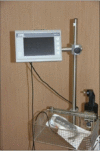A review of video laryngoscopes relevant to the intensive care unit
- PMID: 25097357
- PMCID: PMC4118510
- DOI: 10.4103/0972-5229.136073
A review of video laryngoscopes relevant to the intensive care unit
Abstract
The incidence of difficult direct intubation in the intensive care unit (ICU) is estimated to be as high as 20%. Recent advances in video-technology have led to the development of video laryngoscopes as new intubation devices to assist in difficult airway management. Clinical studies indicate superiority of video laryngoscopes relative to conventional direct laryngoscopy in selected patients. They are therefore an important addition to the armamentarium of any clinician performing endotracheal intubation. We present a practical review of commonly available video laryngoscopes with respect to design, clinical efficacy, and safety aspects relevant to their use in the ICU.
Keywords: Difficult airway; intensive care unit; video laryngoscopes.
Conflict of interest statement
Figures









References
-
- Crosby ET, Cooper RM, Douglas MJ, Doyle DJ, Hung OR, Labrecque P, et al. The unanticipated difficult airway with recommendations for management. Can J Anaesth. 1998;45:757–76. - PubMed
-
- Benumof JL. Management of the difficult adult airway. With special emphasis on awake tracheal intubation. Anesthesiology. 1991;75:1087–110. - PubMed
-
- Tayal VS, Riggs RW, Marx JA, Tomaszewski CA, Schneider RE. Rapid-sequence intubation at an emergency medicine residency: Success rate and adverse events during a two-year period. Acad Emerg Med. 1999;6:31–7. - PubMed
-
- Sakles JC, Laurin EG, Rantapaa AA, Panacek EA. Airway management in the emergency department: A one-year study of 610 tracheal intubations. Ann Emerg Med. 1998;31:325–32. - PubMed
-
- Heuer JF, Barwing TA, Barwing J, Russo SG, Bleckmann E, Quintel M, et al. Incidence of difficult intubation in intensive care patients: Analysis of contributing factors. Anaesth Intensive Care. 2012;40:120–7. - PubMed
Publication types
LinkOut - more resources
Full Text Sources
Other Literature Sources
